The Windows RT Review
by Vivek Gowri & Anand Lal Shimpi on October 25, 2012 12:00 PM EST- Posted in
- Windows RT
- Operating Systems
- Microsoft
- Mobile
- Windows 8
- Tablets
First Party Applications
Microsoft has bundled in a healthy suite of first party applications for Modern UI, including obvious suspects like Internet Explorer, Mail, Calendar, People, Maps, Messaging, and Bing, as well as apps for things like news, finance, sports, weather, remote desktop, and media playback, amongst others.
There’s also a list of desktop applications that’s a little less heartening. The familiar old Windows Accessories are still sticking around, with favorites like Paint and Notepad joined here by the classic Remote Desktop Connection application, Snipping Tool (another holdover from the Windows Tablet PC days), the Math Input Panel, and XPS document viewer. Ease of access applications, too, are desktop-based, as are system functions like Control Panel, Command Prompt, File Explorer, Task Manager, and the Run dialog. Personally, I’m disappointed that there wasn’t a Modern UI version of Command Prompt because, let’s face it, how cool would that be?
You’ll note that I left out the headlining Windows RT application: Office 2013. It’s one of the most vital pieces to the Windows RT puzzle, so it demands a bit more context - I’ll get to it in a bit, after running through some of the more notable first party applications.
The mail application here is decent, with an ultra-spartan design and a straightforward 3-column layout. You get accounts and folders on the far right, a middle column with the sender, subject, and thread information. When you expand a multi-email thread, a message preview is also shown. Finally, in the main part of the window, the selected message is displayed. If you’ve used any recent version of Outlook or Hotmail, the layout and implementation should be instantly familiar except for the Metro visual style. Compose, reply, and delete are located in the top right corner of the email window, while mark as unread and move to folder are located in the bottom edge swipe bar.
As far as options go, there really isn't much to mess with - just the ability to turn off threaded messaging. You can connect any EAS, IMAP, or POP email accounts, with support for Hotmail, Gmail, Exchange, AOL, and Yahoo mail accounts built in already. For Gmail accounts, the delete button actually just archives things - to really delete mails, you need to move the message to the deleted folder.
Mail isn't Outlook, and usability is far from perfect. Manual syncing requires an edge gesture to reveal the sync button and there's no way to just tap on a sender's name and create a new email. There are other little issues like these that keep Mail from being a best in class tablet email client. Mail works, it just isn't great.
Calendar
The calendar application is similarly focused - a very clean user interface with not too much power, but it does exactly what it needs to. It will sync to Hotmail, Google, and Outlook calendars, and I'm hoping that once there is a Facebook application, it will sync to that as well. You can pick between day, week, and monthly resolution from the bottom swipe menu, which is also where you add new calendar events. Options for adding new calendar events include date, time, length, location, repetition and reminders - the standard list. The UI is again very touch-centric, so trying to use the calendar with just the mouse is slightly frustrating since everything is hidden in the edge swipe bar. Thankfully, pressing or clicking on a particular day/time takes you directly to a new event creation page, which is pretty convenient. I like the way the calendar application operates, and the visual style is perfect for getting the information you need at a glance. Power users might find it lacking, but for basic tasks, it's more than adequate.
Messaging
The messaging application is one that has so much potential, but needs more to really be useful unless you only use Live Messenger and Facebook Chat. Personally, given the Skype acquisition and the combining of the Windows and Skype IDs (I’ll get to this later, but basically when you login to Skype, your Windows ID is linked to your Skype ID), I feel like the Messaging app should either include Skype chat in it or somehow fuse Skype with the messaging protocols already in place. I personally rely on Google Talk, and in an ideal world it would be supported as well, but I won’t hold my breath.
Nobody I know has used Live Messenger since it stopped being MSN Messenger, so I reserved most of my testing for Facebook Chat. It’s a good looking chat interface, but using it full-screen is a total waste of display real-estate. Messenger is an application that lives for Windows 8 Snap, and it’s really the perfect app to show off that capability with. Finally, a tablet operating system that’s good for instant messaging.
Bing News, Sports, and Travel
There are a variety of Bing-based applications here - News, Sports, Travel, and of course, Bing itself. I personally don’t find too much point to the Bing search app, since if I’m already in the browser it’s much easier just to search from the URL bar.
The other applications are somewhat interesting though. Sports and News are very similarly designed, so I’ll cover them together. Basically, there’s a top story that takes up most of the front page. You can horizontally scroll through a number of other headlines, aggregated from various news sources (Reuters, NYT, AP, etc) and separated by category - US, World, Technology, Business, etc. You can choose to browse the “Bing Daily” news, news specially targeted towards you, or pick from the list of sources to see each one individually. (My feed was full of technology news, wonder why.) Sports is essentially the same thing, except with the categories being sorted into the various sports. You can pick favorite teams, look at all the day’s sporting news or just the particular sport you want to see.
In either case, the articles are presented in a clean, easy to read format. For a one-stop-shop news source, it’s pretty decent. The overall treatment reminds me a bit of Flipboard a bit, while the articles themselves are displayed in a reading optimized context like Apple’s Reader mode in Safari. The treatment is obviously different - horizontal columns and page scrolling, but it’s a generally similar concept.
Bing Travel is a bit different - it has a list of popular destinations, and features numerous photos, maps, panoramas, list of attractions, hotels, restaurants, and guides for each city page. From the app, you can research the location, book flights and hotels, and use the application to guide your trip plan in terms of sites and restaurants to visit. Most big cities in each geographic region are listed, though smaller travel destinations are a bit harder to come by. I can see the app being really useful when on travel as a more convenient alternative to Yelp.


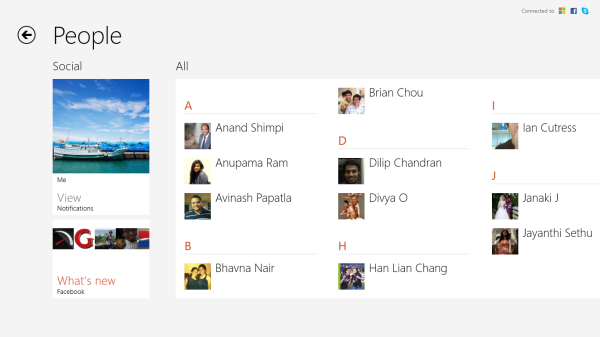

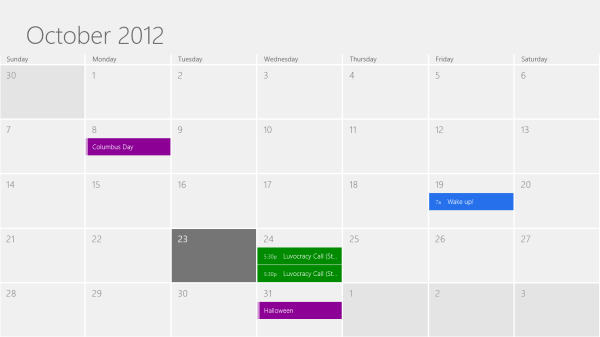
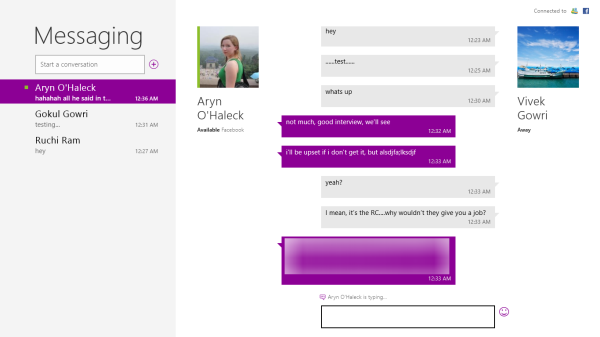

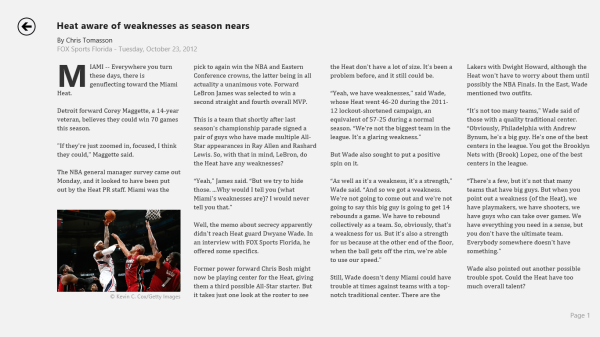
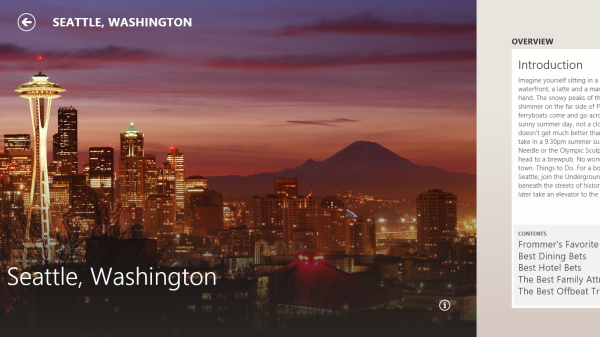








233 Comments
View All Comments
Sherlock - Friday, October 26, 2012 - link
IMHO WIndows RT on ARM is an stop-gap solution till the x86 architecture becoms power efficient to give tablet like running times. I belive Microsoft began working on Surface about two years ago & at that point of time, there was no viable competitor to ARM, in terms of power efficiency. This is the primary reason I belive Microsoft had to create an ARM version.Several of the commentators on this site have mentioned that they see no reason to buy an ARM over x86...and it definitley makes sense. Why have an fragmented ecosystem?
I believe that as time passes on & people get used to the Modern UI & the x86 architecture catches up, Microsft would phase out their support for the ARM version.
Microsoft could have chosen to do away with the "Desktop" environment with Windows RT & created a Moder UI version of Office (I don't agree with the argument of they not having enough time...they have been at it for 2 years) but I guess they deliberately chose to retain it so that users experience the familiar environment while using their killer app in this war - Office. I think people have underestimated the importance of bundling Office with Windows RT which remediates the biggest shortcoming of Android/iOS tablets
prdola0 - Friday, October 26, 2012 - link
Hi, the article is nice, but I keep wondering about one thing. Why do Apple articles start with a nice and colorful image of the devices, and a lot of it's competition articles start with a smudgy ugly images or devices turned off? Maybe it's just accidental, but please give it a thought. It looks a bit like bias.B3an - Friday, October 26, 2012 - link
Lol i've said this before! They often put more effort in to images taken of Apple stuff, which i've never liked as it's bias in way.But to be fair, this time the image at the start of this article is old and to show the Win 7 tablet. It makes sense to have it with the opening of the article.
beginner99 - Friday, October 26, 2012 - link
...but doubtful very usable in practice. I really like the thinking behind Surface with the touch keyboard cover and other things. According to this review Windows 8 isnt that bad on tablets. I'm just gonna believe that.However the Application load times are very, very bad. 7 sec for mail app? That is just frustrating. Just shows that ARM is still very much underpowered....Or that surface uses an extremely crappy flash storage.
milkod2001 - Friday, October 26, 2012 - link
@prdola0this site belongs to Anand a trully Apple fanboy plus there's no such thing as unbiased review, any review on any web is only as good/positive as much is reviewer/site owner getting pay
yyrkoon - Sunday, October 28, 2012 - link
Funny, I thought the review was rather in favor for Microsoft. This review, and the Microsoft surface review. Both.Anand is no dumbie.. I absolutely HATE anything Apple based on pure personal beliefs / reasoning. Yet, even I, can not deny that iOS as far as polish goes is second to none. Until now. And the hardware used is usually top quality.
At a higher cost, with less freedom, and a strangle hold on their software regime. A lot of people claim these are all problems from Microsoft. Which may be true, but Apple trumps Microsoft in computer-land tyranny. Until now.
It could be that 90% of the market will be driven to using Mint Linux x, in the not so distant future. We'll see if Microsoft gets another clue.
GnillGnoll - Friday, October 26, 2012 - link
I very much like that the on-screen keyboard has cursor keys, even if it's just left/right. It's one of the main features missing from the iOS keyboard, as precisely positioning the cursor with your finger is a huge pain.I assume that Ctrl+Left/Right skips words, and that Shift+Left/Right can be used for selection. Does anyone know if there is a way to go up/down?
I don't like that quick access to punctuation is so limited, though.
bitbank - Friday, October 26, 2012 - link
From your comments throughout the article, it's clear that you're a fan of Metro and you overlook many of the shortcomings of Windows Phone and Windows RT just because of the "smooth tiled interface". The truth is that the GUI isn't that important. It's not where you get your work done. Apps are where you work.As you said, an ARM version of Windows is good to wake Intel from their slumber and get some competition in the low cost/low power CPU market. Intel's Sandy Bridge and Ivy Bridge processors get decent battery life and run 3-5x faster than the best ARM offerings to date. I get 8-10 hours of battery life out of my 17" HP Sandy Bridge notebook with the medium capacity battery. I would much rather have an x86 slate running Windows 8 with support for legacy apps. Having a half-baked version of Office on an ARM based WinRT tablet isn't much incentive to be stuck with virtually no apps.
WindowsRT feels a lot like the launch of Windows CE notebooks. Interesting form factors and improved battery life don't make up for lack of app compatibility. The value of Windows is in its huge selection of apps. Win8 Pro is taking the right approach. Similar to the transition from DOS and 16-bit to 32-bit apps with Windows 95, there needs to be a transition product (Win8 Pro) which bridges the gap between old and new. When presented with a completely new device with no legacy support and very little app support, it makes very little sense for the average user to buy it. Besides reviewers and people who have to buy the latest gadget, why should an average person want to buy WinRT? According to you, they should patiently wait for the app store to get some decent apps. That's asking too much. The smart move for the average consumer is to wait a year or so and see if developers have given any attention to Windows 8's "little brother" and published apps in both x86 and ARM versions.
karocage - Friday, October 26, 2012 - link
But the interface is how you navigate all those apps. It's legitimate to point out that WP7 and W8/RT have clearly surpassed iOS in terms of speed of navigation between things like the back button, hubs, task switcher, charms and so on. That's not a function of the tiles really - although of course the tiles are another place where MS has a much better implementation than Apple.steven75 - Friday, November 2, 2012 - link
Completely disagree on speed of navigation. Are you familiar with the four-finger swipes on an iPad to switch apps, bring up the "task manager" tray, etc?I'll give you getting to the settings screen to find apps settings takes longer but thankfully on iOS apps launch lightning fast unlike on RT.